The Way It Is/ The rear engine revolution at Indianapolisby Gordon Kirby |
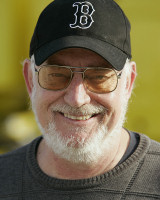 In this space two weeks ago I told the story of the height of the roadster era at Indianapolis. This week we look at the end of the line for the roadsters as the rear engine revolution arrived at Indianapolis with full force between 1963-'65.
In this space two weeks ago I told the story of the height of the roadster era at Indianapolis. This week we look at the end of the line for the roadsters as the rear engine revolution arrived at Indianapolis with full force between 1963-'65.
The dominant Offy-powered roadsters of the late nineteen-fifties and early sixties remained largely unchanged from the basic precepts laid down before World War II and refined in the fifties by classic roadster builders Frank Kurtis, George Salih, A.J. Watson and Quin Epperly. But the sleepy days of the fifties at Indianapolis were blown away by the Lotus invasion of what had long been a strictly American preserve. Over the next ten years a truly amazing technological revolution would take place from the introduction of rear-engine cars and low profile tires to the arrival of wings, aerodynamics and turbocharging. Dramatic increases in downforce, tire grip and engine power would see performance levels raised beyond anyone's wildest imagination. It would turn out to be the apogee of the sport's role in contemporary American culture featuring a series of exciting technical breakthroughs, record crowds and major media interest with All-American Racers' Eagle-turbo Offies ultimately breaking the 200 mph lap speed barrier in 1972. 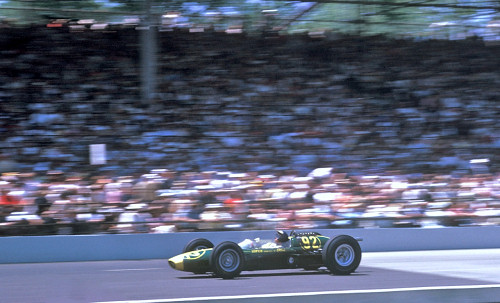 © Racemaker/Knox ~ Clark and the Lotus 29 in 1963 Gurney qualified eighth and ran with the leaders until the transmission failed but the experience convinced him rear engines were the way to go at Indianapolis just as they were in F1. Most Indy experts believed Jack Brabham's run to ninth place in the 1961 Indy 500 with a Cooper Formula 1 car fitted with a stretched 2.6 liter four-cylinder Coventry-Climax engine was an insignificant event. They thought rear-engine cars were too flimsy for Indianapolis and oval racing in general but Gurney disagreed. He decided the best candidate for the job of designing and building a rear-engine Indy car to tackle the USAC establishment was Lotus boss Colin Chapman. So Gurney bought Chapman a London to Indianapolis round trip ticket to watch the 1962 Indy 500. On successive weekends in mid-summer Gurney won the French GP at Rouen and the non-championship Solitude GP in Germany driving a flat-eight Porsche F1 car. The following weekend Gurney and Chapman were in Detroit to visit the Ford Motor Company. Chapman pitched the Ford executives on the idea of Ford developing a stock-block V-8 to power a rear-engine Lotus Indy car. Ford's buttoned-down executives weren't impressed with the supremely confident Chapman. They thought him arrogant and contemptuous of American ways but they were swayed by Gurney's forthrightness as well as his charm and amiability. Gurney's superstar status, broad grin and all-American appeal sold them on Chapman's ideas and the wheels were set in motion for one of the biggest revolutions in the history of American racing. Chapman's plan was to mate Ford's 260 cubic inch push-rod V-8 to a lightweight, aerodynamically clean Lotus chassis and beat the Offy-powered roadsters on weight, handling, reduced drag and better fuel consumption. By running the Ford engine on gasoline rather than the alcohol mixtures preferred by the Offy engine men, Chapman calculated a Lotus-Ford could run the 500 miles on one pitstop compared to two or three for the roadsters. Gurney's biggest worry with Chapman was his insistence on making his cars as light, or even lighter, than seemed possible and Gurney stressed the need for the chassis and running gear of the Indy Lotuses to be substantially stronger than the company's successful F1 cars. 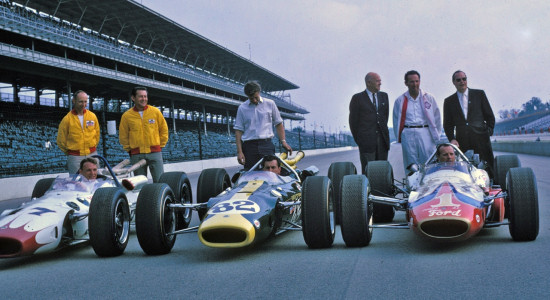 © Racemaker/Knox ~ The front row at Indy 1965 Jim Clark and Gurney qualified their Lotus-Fords fifth and twelfth in 1963 and Clark finished second to Parnelli Jones in the race with Gurney making it home seventh. The following year they ran into tire trouble after Chapman insisted on running Dunlops rather than the Firestone rubber preferred by Ford. Clark led the race but less than a quarter of the way into the 500 his left rear tire threw a tread, breaking his car's rear suspension. Meanwhile, Gurney was never happy with his car and Chapman pulled him into the pits and out of the race after Clark's tire problems. Following the 1964 500 Ford insisted on buying two type 34s from Lotus and selecting who would drive them in any other USAC races that year. Ford wanted Jones and A.J. Foyt in the cars and sure enough, at Milwaukee in August, the pair of USAC superstars were aboard the factory Lotuses. Clark and Gurney were busy that weekend at the Austrian GP and Jones won the race after Foyt hit gearbox trouble at the start. The cars appeared once more that year, at Trenton in September, with Jones and Clark doing the driving. Jones won again while Clark dropped out because of a holed water radiator. At the end of the year Bobby Marshman crashed Lindsey Hopkins' Lotus and was grievously burned while testing at Phoenix. Marshman succumbed to his injuries seven days later. Eddie Sachs and Dave MacDonald had lost their lives in a terrible fire during the opening laps of that year's 500 and in response USAC made some serious rule changes for 1965. Gasoline was banned in favor of methanol and fuel tank capacity was restricted to 75 gallons. Two mandatory pitstops were required for a 500-mile race and pressurized refueling was also banned. Also specified for 1965 were crushable fuel cells like those built for aviation use in military helicopters. 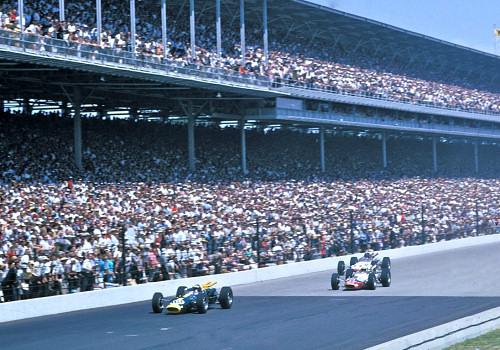 © Racemaker/Knox ~ Clark leads Foyt and Gurney in 1965 Lotus was in much better shape for 1965 with the full monocoque Lotus 38 designed by Len Terry. Clark and Bobby Johns drove the new factory Lotus 38s on Firestone tires with Gurney in his own AAR type 38 on Goodyears. A.J. Foyt and Parnelli Jones were in the previous year's Lotus 34s. Foyt took the pole from Clark and Gurney so that Lotus swept the front row for the first time and rear-engine cars began to push the traditional roadsters out of the Indy 500. Only six front-engine cars made the field in 1965. Clark went on to score a dominant win leading all but ten laps and beating Parnelli Jones by almost two minutes after Foyt dropped out with transmission failure. Gurney ran third in the opening laps behind Clark and Foyt, fighting an ill-handling car. He was soon passed by Jones, then his engine went off-song as the timing gears failed, ending his race after only forty-two laps. Gurney raced his Lotus 38 in two more races that summer, both at Milwaukee. He finished third in a 150-mile race in August then dropped out of the following week's 200-mile race because of an engine failure. Of course, the following year Gurney debuted his own beautiful and very effective Eagle Formula 1 and Indy cars. He went on to win the Belgian GP in 1967 aboard his superb Eagle-Weslake V12 and would finish second at Indianapolis in 1968 and '69 and third in 1970, his last start in the 500. And Eagles would win the Indy 500 in 1968 and 1975 driven by Bobby Unser and in 1973 with Gordon Johncock. Meanwhile, the 1965 season also marked the emergence of Mario Andretti as a new motor racing super star. Andretti finished third at Indianapolis in his rookie start in the 500 in 1965 and went on to win that year's USAC Championship, the first of three he would win over the next five years. Andretti started racing Indy cars for Clint Brawner's Dean Van Lines team in the second half of 1964. He drove Brawner's Watson-Offy roadster and a Kuzma-Offy dirt car through 1964 and started the 1965 season with the old cars plus a new, lightweight roadster built by Brawner. But at Indianapolis Brawner rolled out his first rear-engine car based on a Brabham chassis. The Brawner/Hawk was powered by a Ford V8 and was the first rear-engine car Andretti drove. The new car was based on a Brabham tube-frame chassis rather than the aluminum monocoque used by Lotus and Lola, which Brawner and many Indy veterans thought were flimsy. Brawner believed the more traditional tubular chassis would be safer and more easy to adjust and tune for each track. 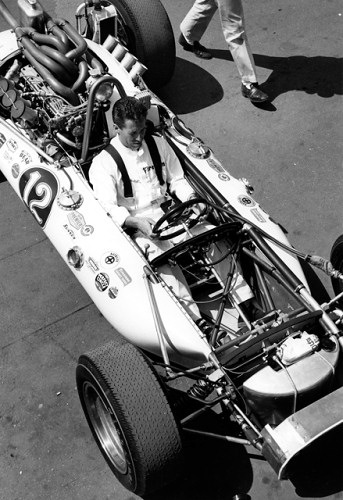 © Racemaker/Friedman ~ Andretti in the Brawner/Hawk Neither Brawner nor Andretti had any experience with rear-engine cars so Andretti drove Brawner's new lightweight roadster in the first two races of the season at Phoenix in March and Trenton in April. He qualified third at Phoenix behind a pair of rear-engine cars driven by A.J. Foyt and Rodger Ward and led the race before having to spin to avoid Johnny Rutherford's spinning car. Andretti recovered to finish sixth while Don Branson, also driving a traditional front-engine roadster, inherited the victory. That was the last time a roadster would win a USAC Championship race. Front-engine cars would continue to win on the dirt through 1970, but would never again win on a paved track. At Trenton the following month, Andretti again mixed it up with the rear-engine brigade. He qualified fifth but was soon chasing early leaders Foyt and McElreath in their rear-engine machines. Foyt dropped out, leaving Andretti to battle with McElreath until McElreath used slower traffic to pull away. Andretti settled for second, his best Championship result to that point. Then came Andretti's rookie month of May at Indianapolis. In those days, there were no fewer than three weeks of practice at Indianapolis with the track opening on May 1. But the brand new Ford-powered Brawner/Hawk wasn't ready until the middle of the second week of practice. Pole Day in 1965 fell on May 15 and Andretti didn't get onto the track until May 9. An engine failure on his first day cost more time. He first of all had to complete his rookie test, but after just one day of practice he was ready. He cruised through the test without any drama, taking immediately to the track and car. That left only two days before Pole Day, yet by the end of that week Andretti was as quick as anyone. "I was lucky because the car was so good," he grins. "It really didn't need any serious sorting-out. To me, as a driver, it felt good right away, and the more I learned, the more I enjoyed it." Andretti drew an early place in the qualifying line and set new one and four-lap records in his rookie qualifying run, averaging 158.849 mph for the four laps. Right away however, he was beaten by Jim Clark in the factory Lotus-Ford, and then both were beaten by Foyt who was driving a 1964 Lotus 34-Ford. Before the day was over Dan Gurney made it an all-Lotus front row as he also beat Andretti, knocking him back to the inside of the second row.  © Racemaker/Knox ~ Andretti in the pits in 1965 Andretti's goal in his first 500 was to make the finish. He let the leaders go in the early laps, and fell back a few places. He later realized he could run a little quicker and was soon back to fifth behind Clark, Foyt, Gurney and Parnelli Jones. And that was where he ran for the rest of the race. Clark dominated, running away to win easily in his third start at Indianapolis. Foyt and Gurney dropped out with transmission and engine problems respectively, while Jones kept Andretti at bay despite running out of fuel as he took the checkered flag. At the end of the race Andretti's hands were badly blistered from fighting the car, and he was completely exhausted. The car's cockpit was improperly ventilated so that Andretti had become overheated as the race wore on, but he was able to make it home in third place, earning the race's rookie of the year award, and was leading the USAC Championship going into round four at Milwaukee the following weekend. In 1965 Jones and Foyt raced a pair of 1964 Lotus 34s owned by Ford. Both cars were substantially rebuilt, Foyt's by George Bignotti and Parnelli's by renowned roadster builder Eddie Kuzma. But the cars still proved fragile. Parnelli suffered two suspension failures during practice at Indianapolis, crashing heavily both times. He was knocked unconscious in the second accident and started the race in the rebuilt car without any serious running. In the end Parnelli and car owner Agajanian were delighted to finish the 500 a distant second to Jim Clark as the Scot scored the first rear-engine win at Indianapolis in his newer Team Lotus 38. Practice began at Milwaukee only four days later so there was no time for Brawner and McGee to re-engineer Andretti's Brawner/Hawk. Mario therefore fought the same problems that were made even worse on the smaller, one-mile Wisconsin oval. He qualified twelfth and finished a distant fourth, helped by a high rate of attrition. With Clark absent from Milwaukee because of his Formula 1 commitments, Parnelli Jones scored a clear win in his Kuzma/Lotus 34. But Parnelli raced the Lotus only once again that year, at Milwaukee the following month, dropping out because of electrical problems. There was an open weekend before the next race at Langhorne which enabled Brawner and McGee to do some work to the Brawner/Hawk's fuel and cooling systems. The fearsome old dirt track had been newly paved and with the Hawk handling better than ever Andretti took pole position and finished a close second to Jim McElreath after leading a few early laps. 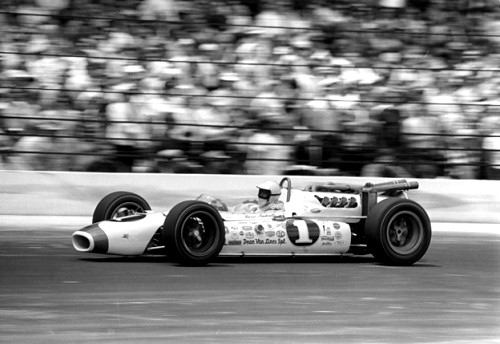 © Racemaker/Friedman ~ Andretti proudly wearing #1 in 1966 The following week saw the first road race for Indy cars in almost thirty years, since the Vanderbilt Cup races on Long Island in 1936 and 1937. The venue was Indianapolis Raceway Park, an oval with an infield road course, and Andretti again qualified on the pole. Andretti's car had only a two-speed, speedway-style gearbox while his primary rival Foyt had a much more effective four-speed Hewland transmission in his Lotus. Foyt's better gearing enabled him to outpace Andretti by almost ten mph on the main straightaway, but Andretti was able to stay with him on the rest of the course. At one point Andretti spun while leading, but was able to catch back up to Foyt and score his first USAC Championship victory after Foyt ran out of fuel beginning the last lap. The win solidified Andretti's lead in the championship and encouraged the team to race their lightweight, Offy-powered roadster one more time in the next race on the high-banked Atlanta speedway. "We did that because we didn't think the suspension on the rear-engined car was strong enough," Mario says. "The uprights and spindles on the Brawner car weren't up to it on a track like that." That was Andretti's last race in a roadster. He qualified eighth and finished second, well behind winner Johnny Rutherford after Foyt and most of the other frontrunners dropped out. There would be no more wins that year from the remaining nine races, but Andretti took three more seconds, a couple of thirds and a fourth. He wrapped-up the championship at Trenton in September with two races still to run. At the Phoenix season-closer Andretti took his third pole of the year and led most of the race, holding off a challenge from Foyt. With just eight laps to go however, Andretti brushed wheels with a lapped car and damaged his car's rear suspension. He had to slow down and nurse it to the finish, which enabled Foyt to pass and win. By that point, Andretti had well and truly arrived. He was the first rookie to win the national championship since Johnnie Parsons in 1949 and the youngest champion in history. Over the next four years with Brawner's well-developed cars Andretti would establish himself as the man to beat in USAC. Next week, I'll take a look at the last half of the sixties from 1966-1970, featuring record speeds, spectacular cars and a battle for supremacy between Andretti, Foyt, Parnelli Jones, Bobby and Al Unser, five of the greatest drivers in Indy car racing's long and storied history. |
|
Auto Racing ~ Gordon Kirby
Copyright ~ All Rights Reserved |
